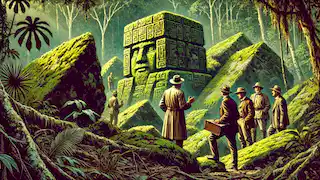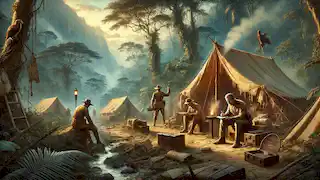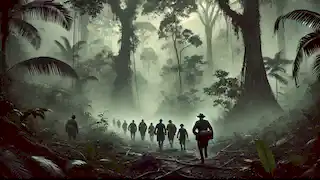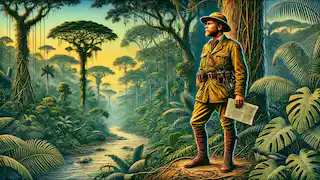{{{_Intro}}}
Deep in the uncharted heart of the Amazon rainforest, cloaked beneath a canopy so thick that sunlight barely pierces through, lies a mystery that has confounded explorers, scholars, and adventurers for centuries: the legend of the Lost City of Z. This city, believed to be a relic of an ancient civilization, has become the focal point of one of the most enduring mysteries of the 20th century. Tales of its existence have been passed down through the oral traditions of indigenous peoples, whispered by those who dared to wander too far into the green abyss, and it was these stories that ultimately drew one man, British explorer Percy Fawcett, into a relentless pursuit. His search for the Lost City of Z, a city believed to be located in the Brazilian Amazon, would consume him, his family, and countless others in a decades-long quest filled with ambition, danger, and unsolved disappearance. The idea of a grand, lost city hidden deep within the Amazon had its roots in the early European conquests of the Americas. When the first Spanish conquistadors ventured into South America, they returned to Europe with fantastic stories of cities made of gold and sprawling civilizations hidden in the dense jungles. These accounts, filled with exaggeration and myth, painted a picture of vast wealth and advanced societies tucked away in regions that few outsiders had ever seen. However, as the centuries passed and no such city materialized, many dismissed these stories as fanciful myths, tales spun to justify failed expeditions and empty-handed returns. But not everyone was so skeptical. There remained a small group of explorers and scholars who believed that beneath the embellishments, there was a kernel of truth—that somewhere in the dense, impenetrable forests of the Amazon lay a city, perhaps not made of gold, but a city nonetheless, built by an ancient and forgotten people. Among these believers was Percy Harrison Fawcett. Percy Fawcett was no ordinary adventurer. Born in 1867, Fawcett was a British Army officer, geographer, archaeologist, and artilleryman. He had served in Ceylon (modern-day Sri Lanka), spent time mapping remote areas for the Royal Geographic Society, and had earned a reputation for his fearlessness and remarkable endurance in the most extreme conditions. His life of adventure was marked by a deep fascination with the unknown, and the mysteries of the Amazon were something that he couldn’t resist. It was during one of his many mapping expeditions in South America that Fawcett first heard the rumors of a hidden city deep within the Brazilian jungle. In 1906, while working on border surveys between Brazil and Bolivia, he encountered native tribes who spoke of ancient ruins and cities that had long since been overtaken by the forest. His curiosity piqued, Fawcett began to collect these stories, compiling them into what he believed was evidence of a lost civilization, a place he would later call “Z.” Fawcett’s theory was bolstered when he came across a strange document in the archives of the Brazilian government in Rio de Janeiro. The document, known as Manuscript 512, dated back to the 18th century and detailed the journey of a Portuguese explorer who claimed to have found the remains of a grand, ancient city deep in the jungle. The manuscript described large stone buildings, wide streets, and an advanced civilization that had mysteriously vanished. The descriptions were vague, but for Fawcett, this was the smoking gun—a confirmation that his theories about Z were not mere fantasies. In 1920, after years of research and preparation, Fawcett launched his first official expedition in search of the Lost City of Z. His team was small but dedicated, consisting of a few close associates and local guides who had an intimate knowledge of the terrain. Fawcett believed that the city lay somewhere in the Mato Grosso region of Brazil, a vast and largely unexplored area marked by dense forests, rugged mountains, and treacherous rivers. {{{1213 }}} The journey was grueling from the very start. The Amazon rainforest is one of the most hostile environments on the planet, with temperatures regularly reaching over 100 degrees Fahrenheit and humidity so thick that even breathing became a challenge. The jungle was alive with threats: venomous snakes slithered silently through the underbrush, swarms of insects descended on the team in waves, and the rivers teemed with dangerous predators like piranhas and caimans. But perhaps the greatest danger came from within the forest itself—a vast, living entity that seemed to swallow everything whole. The dense vegetation was so thick in some places that it took hours to advance just a few hundred feet. Progress was painfully slow, and the team quickly found themselves running low on supplies. Despite these hardships, Fawcett remained undeterred. He kept meticulous notes and took extensive measurements of the landscape, convinced that every step was bringing him closer to Z. Along the way, he and his team encountered numerous signs that suggested ancient human habitation. They found strange pottery fragments, intricately carved stone tools, and, most intriguingly, large geometric mounds that seemed too precise to be the work of nature. Fawcett believed that these were signs of a once-thriving civilization that had long since been swallowed by the jungle. However, as the weeks dragged on and the expedition’s supplies dwindled, it became clear that they would not reach Z on this trip. The team was forced to turn back, disappointed but not defeated. Fawcett returned to England, determined to try again, but his obsession with Z had only deepened. Fawcett spent the next five years preparing for his next—and final—expedition. During this time, he refined his theories about the location of Z and gathered more information from both indigenous sources and European explorers. He became more convinced than ever that the city lay somewhere near the Xingu River in the Mato Grosso, a place so remote that few had ever dared to venture there. In 1925, Fawcett felt that he was finally ready. This time, his expedition would be smaller and more efficient, consisting of only three people: Fawcett himself, his eldest son Jack, and Jack’s best friend, Raleigh Rimell. Fawcett believed that a smaller team would be able to move more quickly and stealthily through the jungle, avoiding both the dangers of the terrain and potential conflicts with hostile indigenous tribes. Before setting off, Fawcett left strict instructions with the Royal Geographical Society and his family: if the expedition failed, no one should attempt a rescue. He was aware of the dangers that lay ahead and did not want others to risk their lives trying to find him. His confidence, however, was unwavering. He was certain that this time, they would find Z. The team departed from the town of Cuiabá in April 1925, heading eastward toward the unexplored reaches of the Mato Grosso. The expedition was a perilous one from the start. The jungle quickly enveloped them, its humid air and thick undergrowth making every step a struggle. As they ventured deeper into the wilderness, they encountered indigenous tribes, some of whom were friendly, offering food and guidance. Others were more suspicious of the outsiders and warned them not to continue. The journey was filled with tension and uncertainty. The team had to cross swollen rivers, hack their way through dense foliage, and fend off swarms of insects. Supplies began to dwindle, and the oppressive heat and humidity made every step agonizing. Still, Fawcett pressed on, driven by the belief that they were close to their goal. For weeks, the team continued to push deeper into the unknown, following what Fawcett believed to be the remnants of ancient roads and pathways that would eventually lead them to Z. The team’s last communication with the outside world came in May 1925, when Fawcett sent a letter from the town of Dead Horse Camp. In the letter, he expressed confidence that they were close to their goal and would soon find the city. After that, there was silence. Months passed with no word from Fawcett or his team. As time went on, speculation about their fate began to grow. Some believed that they had been killed by hostile tribes or succumbed to disease in the jungle. Others thought that perhaps they had found Z and decided to stay, living among the indigenous people they encountered. The Brazilian government, British officials, and countless adventurers all mounted rescue missions in an attempt to find them, but none were successful. Over the years, dozens of people vanished while searching for Fawcett and the Lost City of Z. The jungle seemed to swallow anyone who dared to venture too deep, and the mystery only deepened. Some claimed to have seen Fawcett alive, living among the tribes, but these stories were never verified. Others believed that he had perished, his bones now resting somewhere deep in the heart of the forest, alongside the elusive city he had sought for so long. Though Fawcett’s disappearance remains one of the greatest unsolved mysteries of the 20th century, his quest for the Lost City of Z has had a lasting impact on the world of exploration and archaeology. In the decades since his disappearance, new evidence has emerged suggesting that advanced civilizations did once thrive in the Amazon. Archaeological discoveries, such as the recently uncovered geoglyphs and complex networks of earthworks, hint at the possibility that large cities may indeed have existed in the region, hidden beneath centuries of jungle growth. Fawcett’s story has inspired countless adventurers, filmmakers, and writers, all of whom have been drawn to the allure of the unknown. Though the exact location of Z remains a mystery, the legend endures. Some believe that the city still lies out there, waiting to be found by those brave enough to venture into the heart of the Amazon. The Lost City of Z may or may not exist, but its legacy has become a symbol of humanity’s insatiable desire to explore, to push the boundaries of what is known, and to seek out the mysteries that still lie hidden in the farthest corners of the Earth. In recent years, technological advancements have given archaeologists new tools to explore the Amazon without having to set foot in the jungle. LIDAR technology, which uses lasers to scan the ground from above, has revealed previously unknown structures and settlements hidden beneath the dense foliage. These discoveries have reignited interest in the idea that large, advanced societies once thrived in the Amazon, and some believe that these findings could lead to the eventual discovery of Fawcett’s fabled Z. Yet, despite these advances, the Amazon continues to guard its secrets closely. The Lost City of Z, whether real or mythical, remains a powerful reminder that there are still places on Earth that have yet to be fully explored, where the boundaries between history and legend blur, and where the answers to the world’s greatest mysteries may still lie hidden, waiting to be uncovered.Early Glimpses of the Myth
Percy Fawcett: The Man Behind the Quest
The First Expedition: A Taste of the Jungle’s Perils
Preparing for the Final Journey

Into the Jungle
The Disappearance
Legacy and Ongoing Mysteries

The Modern Search for Z




















